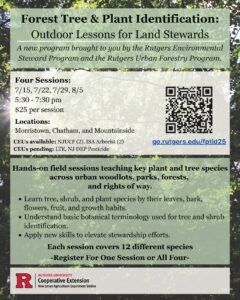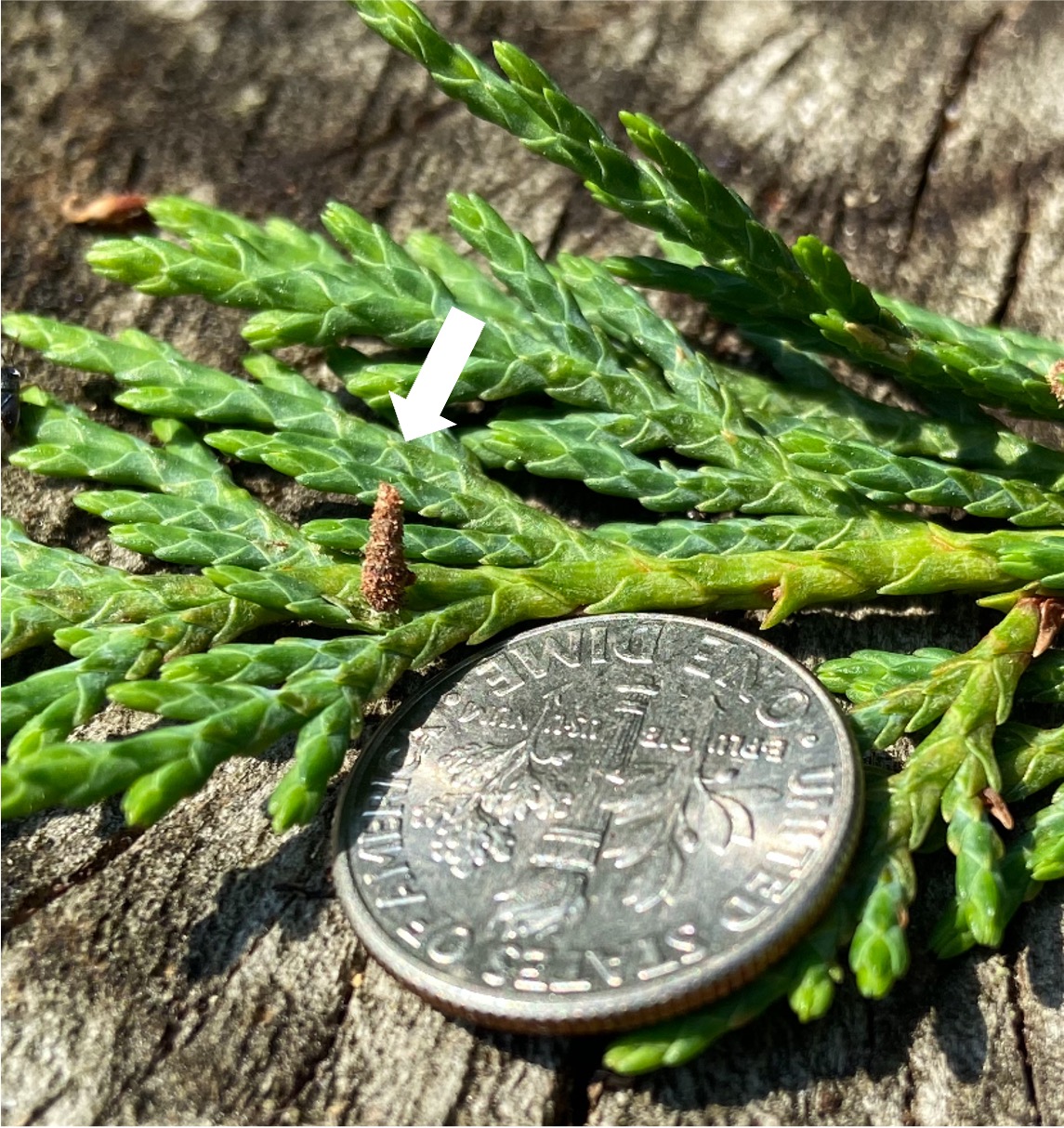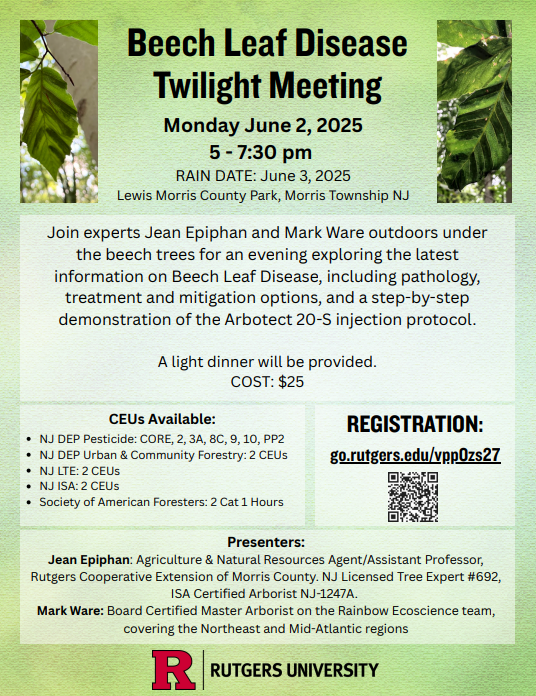
Scan QR code or the link below!
Forest Tree & Plant Identification Outdoor Lessons for Land Stewards
Rutgers Cooperative Extension
Seasonal updates on ornamental, nursery, and turf pests.
Subscriptions are available via EMAIL and RSS.
 Rutgers Turf Blog - Articles on turfgrass diseases and cultural practices for the commercial turfgrass industry. Subscription available via RSS.
Rutgers Turf Blog - Articles on turfgrass diseases and cultural practices for the commercial turfgrass industry. Subscription available via RSS.
 Rutgers Weather Forecasting - Meteorological Information important to commercial agriculture.
Rutgers Weather Forecasting - Meteorological Information important to commercial agriculture.

Scan QR code or the link below!
Forest Tree & Plant Identification Outdoor Lessons for Land Stewards


Bagworms should begin hatching NOW through – 4 weeks in NJ, beginning in the southern regions. Now is an optimal time to get this pest on your radar and prepare materials or approaches to attack first/second instar caterpillars. The control window for this pest is typically between 600-900 GDD50 when they begin to hatch and become airborne, i.e. the “ballooning” phase. It is important to check for egg-hatch prior to applications for greatest chemical efficacy, and to continue scouting as they often hatch and develop at asynchronous rates.
It is critical to target these insects EARLY! We need to target when they are as small as shown in the image.
Bagworm management – mechanical: If eggs have not hatched: hand-remove sacs/bags. Typically female/egg filled sacs are higher in the canopy so keep that in mind while scouting. This removes the problem from the field or landscape.
Treatment options for Lepidoptera (caterpillars) to have at the ready – containing: B.t. (Bacillus thuringiensis), spinosad , bifenthrin ), cyfluthrin, carbaryl, chlorantraniliprole, cyclaniliprole, cyclaniliprole + flonicamid, Lambda-cyhalothrin, cyantraniliprole, Indoxacarb. NOTE – Lethal pesticide doses are important, as sub-lethal doses can trigger early pupation, making the pest all but invincible to chemical or biological treatments. Follow label exactly.
Note we have clearwing borer lures and wing or delta traps, scale crawler tape, and yellow sticky cards available to commercial grower program members at our Cumberland (twaller@njaes.rutgers.edu) and Monmouth (william.errickson@njaes.rutgers.edu) RCE offices.
ALERTS:
UPLOADS 5/27 SESSION: (contains information on flathead borers (Bronze Birch, Emerald Ash), Armored scales, bagworms, Volutella blight in Boxwoods, Mildews)
Previous webinars:
(click the ‘Read More’ below for complete dates in S-C-Northern NJ per pest)

Heat exposure for agricultural laborers should be a consideration when working outside and even in non-airconditioned buildings. When a person’s ability to adapt to heat stress is exceeded, exposure can lead to reduced productivity, mistakes in job performance, increased workplace incidents, and/or heat-related illnesses. Each person’s heat tolerance varies and several factors including type of physical activity, fitness level, underlying health issues, temperature, sun exposure, air movement (wind), and humidity can dramatically impact the potential for heat stress. To determine the level of heat risk, employers should consider the job, the environment, and the worker.
Evaluate the Risk of Heat Stress:
Monitoring the environmental conditions during work times to make management decisions for workers is an important part of preventing heat-related illnesses. Temperature is not the only factor in implementing heat stress management. Humidity is another important consideration. The heat index is a measure of how hot it feels when the relative humidity is factored in with the actual air temperature.
An environmental heat assessment should account for the following factors: air temperature, humidity, radiant heat from sunlight or other artificial heat sources, and air movement. OSHA recommends the use of wet bulb globe temperature (WBGT) monitor to measure workplace environmental heat. OSHA provides this link to calculate the WBGT for a specific location. There is also a NIOSH/OSHA Heat App for Android and iPhone devices that uses the Heat Index as a screening tool.
Management Suggestions for Enhancing Heat Tolerance:
Acclimatization (to heat) is a process of adaptation that involves a stepwise adjustment to heat over a week or sometimes longer. An acceptable schedule for achieving acclimatization is to limit occupational heat exposure to one-third of the workday during the first and second days, one-half of the workday during the third and fourth days, and two-thirds of the workday during the fifth and sixth days. The acclimatization procedure should be repeated if a person misses workdays after days off due to illness, vacation, or other reasons for missing one week or more of job duties.
Fluid replacement:
Provide adequate drinking water for all employees. Recommend to employees they drink plenty of water before work shifts, during work, and after work. Simply relying on feeling thirsty will not ensure adequate hydration. To replace the four to eight quarts of sweat that may be produced in hot environments, people require one-half to one cup of water every 20 minutes of the workday. Potable drinking water kept at a temperature of 59°F or less is recommended.
Physical Fitness: Physical fitness is extremely important. The rate of acclimatization is a function of the individual’s physical fitness. The unfit worker takes 50 percent longer to acclimate than one who is fit.
Increasing Safe Work Practices:
To find management and guidance tools for determining whether to implement heat stress management plans refer to the CDC documents on Heat Stress and Work/Rest Schedules.
The following list of management options should be considered to prevent heat stress for workers:

Details:
About: Join experts Jean Epiphan and Mark Ware outdoors under the beech trees for an evening exploring the latest information on Beech Leaf Disease, including pathology, treatment and mitigation options, and a step-by-step demonstration of the Arbotect 20-S injection protocol.
Presenters:
CEUs Available:
NJ DEP Pesticide: CORE, 2, 3A, 8C, 9, 10, PP2
NJ DEP Urban & Community Forestry: 2 CEUs
NJ LTE: 2 CEUs
NJ ISA: 2 CEUs
Society of American Foresters: 2 Cat 1 Hours
PREVIOUS SESSION: (contains information on boxwood pests, armored scales, needlecast diseases, oomycetes )
Note we have clearwing borer lures and wing or delta traps, scale crawler tape, and yellow sticky cards available to commercial grower program members at our Cumberland (twaller@njaes.rutgers.edu) and Monmouth (william.errickson@njaes.rutgers.edu) RCE offices.
ALERTS:
Previous webinars:
(click the ‘Read More’ below for complete dates in S-C-Northern NJ per pest)
Cooperating Agencies: Rutgers, The State University of New Jersey, U.S. Department of Agriculture, and Boards of County Commissioners. Rutgers Cooperative Extension, a unit of the Rutgers New Jersey Agricultural Experiment Station, is an equal opportunity program provider and employer.
Rutgers University is an equal access/equal opportunity institution. Individuals with disabilities are encouraged to direct suggestions, comments, or complaints concerning any accessibility issues with Rutgers web sites to: accessibility@rutgers.edu or complete the Report Accessibility Barrier or Provide Feedback Form.
Copyright © Rutgers, The State University of New Jersey, an equal opportunity, affirmative action institution
Copyright © 2025 · Generate Child Theme on Genesis Framework · WordPress · Log in